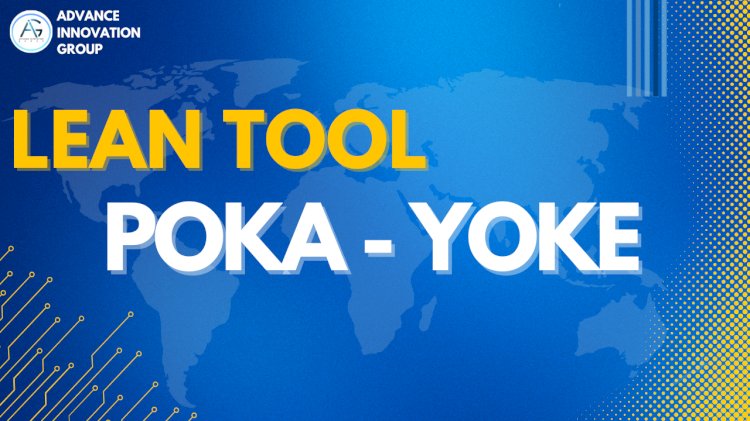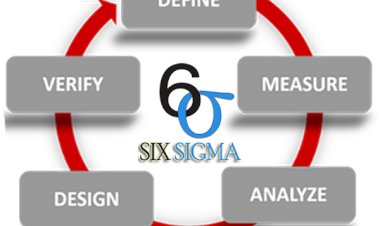Poka-Yoke: The Key to Error-Proofing Processes and Enhancing Quality
"Explore Poka Yoke, a lean manufacturing principle designed to prevent errors in processes and improve product quality. Learn how this mistake-proofing technique enhances efficiency, reduces defects, and fosters a culture of continuous improvement in businesses of all sizes."

Introduction
In today’s highly competitive business environment, where the demand for high-quality products and services is ever-increasing, minimizing errors and defects is crucial for success. To meet this challenge, organizations across industries are increasingly turning to Poka-Yoke—a concept rooted in Japanese manufacturing—that offers an effective approach to preventing errors before they happen. Poka-Yoke, which translates to "mistake-proofing" or "error-proofing," refers to a set of techniques embedded within process design to ensure that human errors are prevented, detected, or corrected at the earliest possible stage. By implementing Poka-Yoke systems, businesses can achieve higher product quality, increased operational efficiency, and improved customer satisfaction.
Poka-Yoke's primary goal is to design processes in such a way that mistakes either cannot occur or are immediately identified when they do, thus preventing defects from reaching customers or escalating further down the production line. This approach not only helps to maintain quality standards but also reduces waste, lowers costs associated with defects, and improves overall productivity. By making the process error-resistant from the outset, Poka-Yoke contributes to an environment where continuous improvement becomes part of the organizational culture.
In a world where competition is fierce, and consumer expectations are higher than ever, adopting Poka-Yoke techniques can provide businesses with a significant edge, ensuring they consistently deliver high-quality products and services while minimizing the risks associated with human errors.
Understanding Poka-Yoke
Poka-Yoke, a term introduced by Shigeo Shingo, a Japanese engineer and a key contributor to the Toyota Production System (TPS), is based on a straightforward yet impactful idea: designing processes, tools, or systems to prevent mistakes from occurring or to quickly detect them when they do.
The main goal of Poka-Yoke is to incorporate error-proofing mechanisms into workflows, reducing the likelihood of human errors. By doing so, organizations can lower defects, increase efficiency, and cultivate a culture focused on quality. This approach is applicable in a wide range of industries, including manufacturing, healthcare, retail, and services, helping to optimize processes and reduce errors across various sectors.
Types of Poka-Yoke Mechanisms
Poka-Yoke mechanism can be classified into two main categories:
Prevention-Based Poka-Yoke: These methods focus on preventing mistakes from occurring in the first place. For instance, designing parts that can only be assembled in one direction or creating processes that are foolproof. Prevention-based Poka-Yoke typically involves changes to the design, such as using custom jigs, fixtures, or error-resistant machinery that guide operators to complete tasks correctly and avoid errors during production.
Detection-Based Poka-Yoke: These mechanisms don't stop errors from happening but ensure that they are immediately detected. Detection-based Poka-Yoke systems alert operators when a mistake is made, allowing them to take corrective action before the product proceeds to the next stage. Examples of detection-based Poka-Yoke include the use of sensors, alarms, or automated checks that identify and flag any discrepancies in real time.
Examples of Poka-Yoke in Action
some practical examples that demonstrate how Poka-Yoke is applied in different industries:
Manufacturing: In production lines, a common example of prevention-based Poka-Yoke is the design of parts that can only be inserted in one specific way. This ensures that assembly errors are avoided, as the part cannot be inserted incorrectly.
Automotive Industry: In automotive assembly lines, Poka-Yoke devices such as sensors can be used to check if components are properly aligned before assembly. If a part is misaligned, the system automatically stops the line until the issue is resolved, preventing faulty assemblies.
Healthcare: In the medical field, Poka-Yoke is employed to prevent medication errors. For example, a medication dispensing system may require the input of a patient’s ID, ensuring the correct dosage is dispensed, which helps prevent accidental overdoses or incorrect medications.
Retail: In self-checkout systems, Poka-Yoke mechanisms detect errors such as scanning the same item multiple times or failing to place an item in the bagging area. If an error occurs, the system alerts the customer, prompting them to fix the mistake before completing the transaction.
Benefits of Poka-Yoke
The advantages of implementing Poka-Yoke systems are both significant and wide-ranging:
Reduced Errors and Defects: Poka-Yoke systems effectively prevent or detect errors early, resulting in fewer defects in products or services, which directly enhances overall quality.
Improved Productivity: By minimizing the need for rework and extensive quality checks, Poka-Yoke streamlines processes, allowing operations to run more efficiently and increasing overall productivity.
Lower Costs: With fewer defects and less waste, Poka-Yoke reduces the costs related to scrap, rework, and quality control, making the production process more cost-effective.
Enhanced Customer Satisfaction: When products and services are consistently defect-free and meet customer expectations, satisfaction increases. This not only strengthens the brand reputation but also encourages long-term customer loyalty.
Employee Empowerment: Poka-Yoke creates a work environment where errors are minimized or easily detected, fostering greater confidence among employees. This can lead to higher job satisfaction, a sense of responsibility, and improved morale.
Implementing Poka-Yoke in Your Organization
Implementing Poka-Yoke within your organization requires thoughtful planning and integration with your existing processes.
Identify the Process: Begin by analyzing your workflows to identify areas prone to human error. This can be done through techniques such as process mapping or Failure Mode and Effects Analysis (FMEA) to pinpoint where mistakes are most likely to occur.
Design Error-Proof Solutions: Once you’ve identified potential failure points, design or select appropriate Poka-Yoke mechanisms. This could involve redesigning tools, incorporating sensors, or adding automated checks to prevent errors from happening.
Test and Validate: Before fully implementing the Poka-Yoke solutions, test them under real conditions. This allows you to identify any challenges and make necessary adjustments to ensure smooth integration.
Train Employees: Provide proper training to employees so they understand how the new error-proofing mechanisms work and how to interact with them. Ensuring that everyone is on the same page is crucial for the system’s success.
Continuous Improvement: Poka-Yoke should be viewed as a process, not a one-timer tool or technique. Regularly review and assess the effectiveness of your Poka-Yoke mechanisms, adjusting and improvement as needed to maintain efficiency and quality.
Conclusion
Poka-Yoke is a highly effective strategy for organizations committed to reducing errors and enhancing the quality of their products and services. By emphasizing the prevention of mistakes or the early detection of errors, businesses can streamline processes, improve reliability, and achieve operational excellence. Regardless of industry—whether manufacturing, healthcare, or service sectors—implementing Poka-Yoke can significantly boost both operational efficiency and customer satisfaction.
With its demonstrated success across multiple industries, Poka-Yoke is not merely a theoretical concept but a practical, actionable approach that can drive continuous improvement and position organizations for sustained success in a competitive marketplace.

 Pranay Kumar
Pranay Kumar 































Comments (0)
Facebook Comments